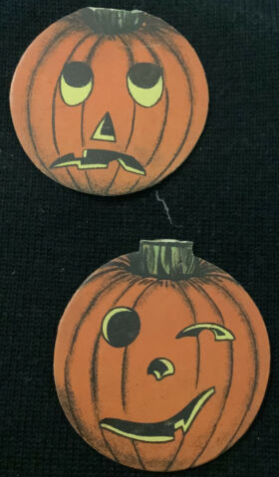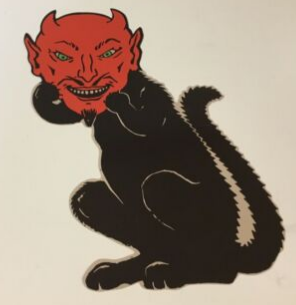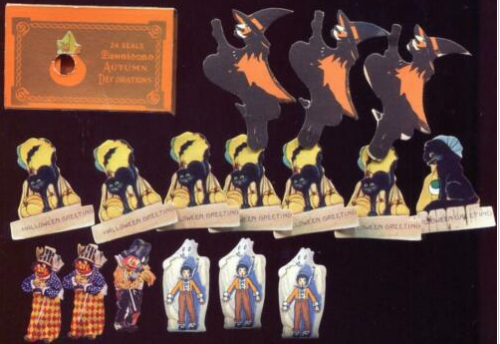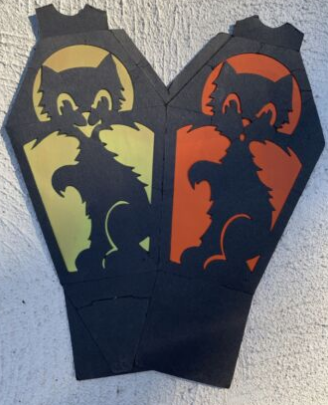Blog
Evolution of Beistle's Party Sets
I recently acquired this Beistle enveloped party set, complete with all contents. In examining it closely, I realized that I may have gained an insight into the evolution of Beistle’s efforts to create party sets. Their first effort was no doubt for the 1918 season. That example is shown on page 217, upper left. The enveloped Complete Party Outfit shown on the same page at the upper right was attributed to 1922. I know now this is an error. (In reading the marketing verbiage more carefully in a copy of a 1921 Beistle catalog for retail shop owners, it clearly states that that enveloped set enjoyed great sales in the two previous seasons - 1919 and 1920. They continued to offer this set for the 1921 season, too. I have updated the book’s errata page.) I believe now that the enveloped set shown below was offered for the 1922 season only. It represents the earliest evidence of Beistle’s fairy motif mania that reached full bloom the following year. The set shown below, also shown in Campanelli’s great reference on page 112, has larger invitations, nut cups and fortune place cards than one sees starting with the 1923 effort. The 1922 iteration also included a fortune puzzle that was quickly dropped, not to be included in any party set going forward. Now, we all know that Beistle scored a home run with their party sets that first appeared in 1923. Their first iteration was a boxed set with slightly different verbiage from the sets much more commonly seen. That first iteration lasted for perhaps a month, and is truly rare. Once Beistle settled on the final cover verbiage and adopted what would become a smaller but standard sizing for the invitations, nut cups and fortune place cards, they pumped out significant quantities of the 1923 party set in three forms: boxed, enveloped and in the form of a booklet, which itself had two iterations - one with white pages and one with orange pages. Interesting, huh?
Rare 1935 German Halloween diecut Cat & Boys & Girls hand in hand against fence.
I’ve had several email exchanges with the wonderful seller of this rare German fence diecut. She saw the article in a recent issue of Antique Trader listing my ten favorite vintage Halloween items. One of them, this diecut fence design, I valued at $4,500. That estimated value prompted her to list the fence diecut she acquired ~30 years ago from an estate sale, wherein she and a business partner acquired a box of vintage Halloween items for pocket change. She told me that through a thrift or antique shop she used to run with that partner, all of the Halloween items acquired that day were long ago sold - except the fence. She listed the diecut on eBay with a “make an offer” feature. She said she received multiple offers in the $2,000 range (c’mon people!) and declined them all until someone stepped up and paid very close to my estimate in the Antique Trader. Although she received a market price for the rarity, nonetheless she was sad to see it packaged up and sent away to the savvy buyer. (I say savvy because when something this rare pops up, you pay up. Those offering a pittance for a treasure hoping to snag a bargain happily lost out.
Now, eBay’s increasingly opaque system shows the fence diecut selling for $1,000. Reading this post, you know now that is inaccurate. (I strongly dislike the opaque approach eBay takes to reporting actual selling prices. It is a true detriment to understanding the foibles of the secondary markets.)
This diecut is rare enough that I wasn’t able to locate one good enough for the collection until just 2-3 years ago. Know that these diecuts were shipped folded. The fold line is between the second and third figures. Although there aren’t too many complete examples extant, many of the ones I’ve seen have separated at this fold line. Many, too, are missing the left-most figure for some reason.
Happy Halloween!
The Happiest of Halloweens to my faithful readers! I hope tomorrow is a fun-filled day.
Article in Antique Trader
The Antique Trader, a superb magazine for the general collector, has been revitalized under the stewardship of its editor, Paul Kennedy. His gently humorous column is my first stop and is worth the modest subscription price all on its own.
In its most recent issue was an article profiling my ten favorite items in the collection. I’ve been avidly and aggressively collecting since 1988 and have been very fortunate to have put together a well-curated collection that brings me much joy. It was difficult selecting just ten items, but I did it. Here is the link to the article: https://www.antiquetrader.com/collectibles/ten-greatest-halloween-collectibles
Vintage Halloween Nut/Candy Cups Set of 2
This nut cup design has long ranked as one of my favorites. It uses non-traditional colors with solid Halloween imagery to create an eye-catching and intricate item. Here’s a chance to own two at once! The seller is a gem. She was one of the earliest friends I made in the Halloween collecting community, forged over a shared love of well-crafted Halloween folk art. You can buy from her without hesitation.
Although I am not 100% sure, I think this nut cup was made by Gibson. It is stylistically similar to known Gibson items, but I can’t find it in any catalogs.
11/02 Update: Thanks to the inestimable Cindy Vogel, I can now confirm that this beautiful nut cup was, in fact, produced by Gibson. It was sold with stock number 1908. Thanks, Cindy!
VINTAGE HALLOWEEN CAT & DEVIL DIE CUT DECORATION
Dennison Vintage Halloween Letter Seals (16) - 1960's Vintage in Box
Vintage Four Sided Halloween Paper Lantern / DieCut Cats Tear Missing Top Circle
This lantern was produced by Gibson during the 1920s. They used a grade of construction paper that is rather unforgiving - meaning that once you have assembled the lantern, woe to you if you dissemble and re-assemble it. The soft paper will often just crunch up and then split and drop off. If you obtain one, it is best to leave it unassembled. I’ve learned the hard way! :)
Vintage HALLOWEEN Black Cat Face German Die Cut w Transparency! 30's.
I have long said that selling vintage Halloween on eBay in October is risky. Most collectors have spent their budget by the time they begin decorating in early October and so wonderful items sell for much less than they might have at other times. There are notable exceptions, but this is largely true. This diecut is a great example. Two similar ones sold within the last ~15 months for $2,000+. Even though the inserts are faded on this example, I feel the seller would have done better if they had offered it sometime from March to May.
RARE Antique Vintage Halloween BEISTLE Die Cut Pumpkin Blossom Man 1920s
WITCHES MYSTERY ANSWER GAME BEISTLE VINTAGE HALLOWEEN GAME 1933 MINT VINTAGE
Wow, this game is in nice condition. Because of its size, sawtooth edges and the fact that it was meant to be played with, the Witch’s Mystery Answer Game produced by Beistle is often found with bends, missing borders, extraneous writing, staining - and sometimes all of these. This beautiful example brought $330, a relative bargain for the purchaser.
Vintage Halloween Paper Plate USA
When I think of all the many market segments that comprise the universe of vintage Halloween collecting, I often forget about plates. Most plates, especially those by Reed, don’t fetch much, but one manufacturer stands well above the others - Beach & Arthur. Plates by that firm have been fetching very strong dollars for some 2-3 years now. Their designs tend to be unusual and creatively use colors not typically associated with Halloween like yellow and red. The plate listed is one of the more tame designs and has some staining. Even so, I expect the final result will escalate beyond the initial bid of $9.99.
10/17 Update: The plate sol for $38.99.
Halloween Collecting Podcast
I had the pleasure of speaking with Eric Dwinnells of Salem, Massachusetts by phone on the subject of collecting vintage Halloween for his podcast about two weeks ago. His podcast is called Spooky Times with Eric D. The conversation was wide-ranging and lasted about 90 minutes. If you care to listen, the link can be found below. Let me know what you think.
Just letting you know the interview has been posted and you can find it here:
https://spookyas.libsyn.com/205-vintage-halloween-collecting
That's also a good link to use if you want to share it yourself or post it on your website.
RARE ANTIQUE HALLOWEEN ROSEN MAGIC POT BLACK CAT CANDY CONTAINER STORE DISPLAY
Rosen produced some of the most unique ways to contain candy. Their mechanical products are extremely hard-to-find. (Look at pages 116-118.) This particular Magic Pot is sure nice, but has a number of condition issues. Even so, it brought $1,325! So, even though prices seem to have softened very recently, this is an example of a strong price.












